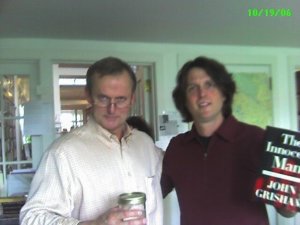Neal Thompson Talks Whiskey
By Richard Thomas

(Credit: Neal Thompson)
One of the things the whiskey boom has brought about is what they are calling “The Golden Age of Whiskey Books.” Books about whiskey and every imaginable intersection with whiskey are coming out just about every week, as we well know here at The Whiskey Reviewer because of how frustrated we are by our inability to read and review them all!
One such book that predates the so-called Golden Age is Neal Thompson’s Driving With The Devil, a tale of how NASCAR rose from the bootlegging of “motherless, dirt-poor southern teens… in jacked-up Fords full of corn whiskey.” Thompson was already a whiskey drinker, but because of the research for that book he joined the growing number of people who discovered that well-made, unaged spirits have a worthy set of virtues all their own.
RT: You described your go-to bourbons as Evan Williams and Bulleit. What is it that you like about those two, besides their reasonable price tags?
NT: Because I’m half Irish and have visited Ireland a few times, I started my adult whiskey-drinking career as a devotee of Jamesons and Powers. But when I started research Driving with the Devil, and learned more about the connections between Ireland, the Scots-Irish, and the southern moonshine that traced it’s origins back to Ireland and Scotland, I realized that bourbon was in a sense a descendant of the irish whiskey I loved. Once I started sampling different brands, I realized I much preferred the deeper flavor of aged bourbon. I should say I have many favorites — Woodford, the new High West Rye, Blanton’s and Bakers, when I feel like splurging. But for day-to-day drinking (two cubes, two fingers) or for Manhattans, Evan Williams and Bulleit are the best deals around. They taste great solo or in a Manhattan.
RT: As a part of researching “Driving With The Devil,” you made the transition from drinking aged whiskey to corn whiskey and moonshine. Tell us about the virtues of the “clear stuff” as you seem them.
NT: I can’t underestimate how shocked I was at how smooth and crisp and tasty I found some of the clear whiskeys to be when I started my research. I describe in the book how my first samples of real moonshine came from my son’s kindergarten teacher, a South Carolina dude with a ponytail who bought it from a guy named One-Eyed Ronny. Usually he got me jars of “brown round,” which I think had been charcoal filtered. But I actually preferred Ronny’s clear stuff. It was bracing, dry, with a sharp bite. I loved to share it with friends — I have a triangle-shaped tray with six shot glasses and an attached bicycle ringer on the handle — and I loved to see their surprise at how good the whiskey was. People usually expect nasty firewater or grain whiskey.
RT: Going further into the virtues of unaged whiskeys, “Driving With The Devil” dwelt on moonshine so much because it was about the connection between bootleggers and early stock car racing. A lot of those guys both drank and hauled moonshine, but do you think they genuinely preferred the “clear stuff,” or did any of those drivers move over to bourbon in the post-war era?
NT: One of the main characters in the book, Raymond Parks, owned a liquor store for decades after his moonshine-running career. When I first visited him at his office — located right beside the liquor store he still owned — I found plenty of bourbons and ryes on the shelves of the store. And I thought it was supremely cool to buy myself a bottle of Woodford Reserve from an ex-moonshiner. In fact, the clerk who sold it to me was a relative of Raymond’s who also ran moonshine back in the day. But I do think there remains a lingering mystique to the clear stuff, which is why you continue to see these faux moonshines gaining popularity, like Junior Johnson’s Midnight Moon.
RT: You have also written a biography of astronaut Alan Shepard, and a recent one about “Believe It Or Not!” Robert Ripley. Did you find any serious whiskey-drinking characters in working on those two books?

(Credit: Neal Thompson)
NT: Ha! It’s an interesting question – I seem to gravitate toward stories about men who like their drink, and Shepard and Ripley certainly liked theirs. Shepard was known to toss back a few, and Ripley was a world-class drinker. In my book, I describe how he used to get very nervous before appearing on stage or on radio, and learned to calm his nerves with a paper cup full of whiskey while he was on air. Later in life, he became a gin and grapefruit devotee, but he continue to rely on that paper cup of whiskey throughout his career.
RT: Dry Fly Distilling paved the way for the micro-distillery scene in Washington some years ago, and now there are several new, small whiskey-makers in your area. Have you sampled any of their wares?
NT: Absolutely. I love seeing some of these small distillers popping up in my neighborhood and around Seattle. I’m a big fan of Fremont Mischief – they make a nice whiskey and a really good rye, John Jacobs Rye. I prefer corn- or rye-based whiskeys, but some distillers are having fun with wheat, like Woodinville Whiskey Co.




Nice work, Sunshine.